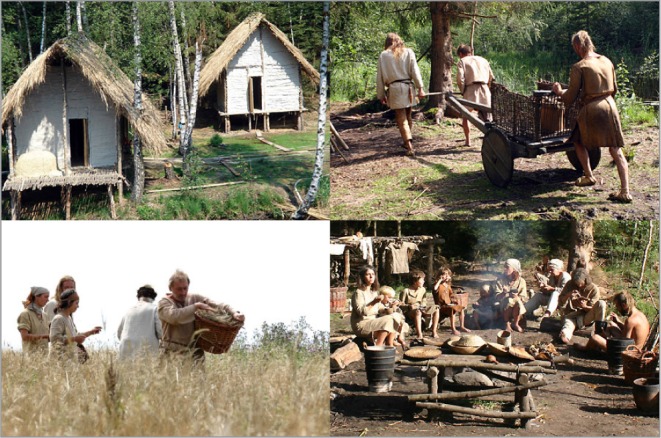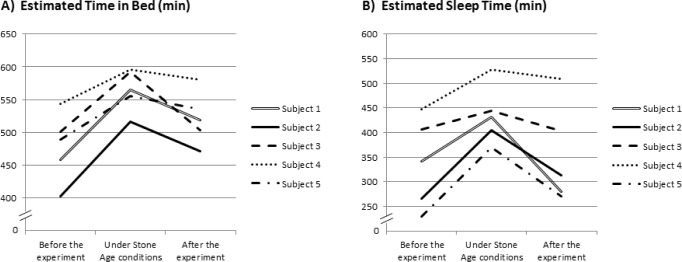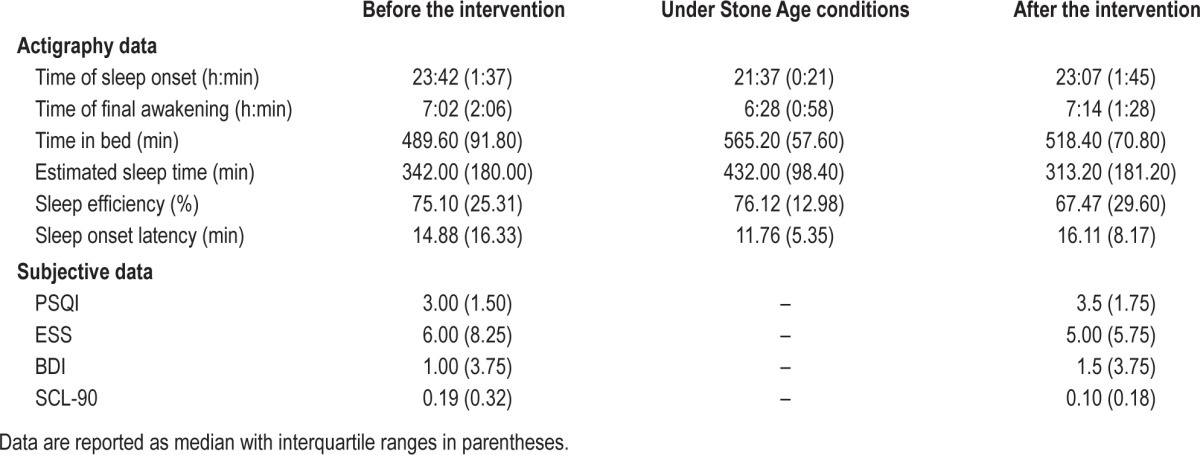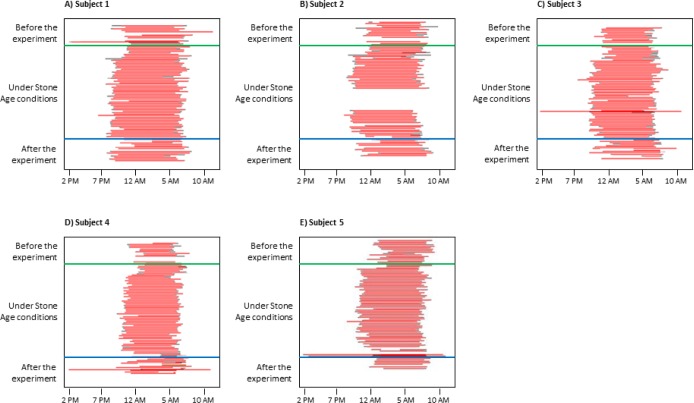Abstract
Study Objectives:
We report on a unique experiment designed to investigate the impact of prehistoric living conditions on sleep-wake behavior.
Methods:
A group of five healthy adults were assessed during life in a Stone Age-like settlement over two months.
Results:
The most notable finding was that nocturnal time in bed and estimated sleep time, as measured by actigraphy, markedly increased during the experimental period compared to the periods prior to and following the experiment. These increases were primarily driven by a phase-advance shift of sleep onset. Subjective assessments of health and functioning did not reveal any relevant changes across the study.
Conclusions:
Our observations provide further evidence for the long-held belief that the absence of modern living conditions is associated with an earlier sleep phase and prolonged sleep duration.
Commentary:
A commentary on this article appears in this issue on page 723.
Citation:
Piosczyk H, Landmann N, Holz J, Feige B, Riemann D, Nissen C, Voderholzer U. Prolonged sleep under Stone Age conditions. J Clin Sleep Med 2014;10(7):719-722.
Keywords: Stone Age, sleep, sleep duration, sleepless society
The twenty-first century world has been characterized as a sleepless 24-hour society.1 In comparison to prehistoric societies, profound lifestyle changes have emerged, such as the adaptation to artificial light, shift work, and the use of electronic media. These changes have been linked to a pronounced alteration of sleep-wake behavior.2 While certain cultural groups, such as the Temiars in Indonesia,3 follow a polyphasic sleep pattern (i.e., they sleep multiple times in a 24-h period), the conditions in industrialized societies enforce a monophasic sleep pattern, which limits sleep to the nighttime period and allows for a short daytime nap at the most.4 This development is accompanied by a widespread reduction in sleep duration,5 which is possibly associated with various physical and mental health problems, such as obesity6 and depression.7 However, despite an extensive theoretical framework, experimental data on the effects of prehistoric living conditions on sleep-wake behavior are largely lacking.
We report on a unique Stone Age experiment, which was undertaken for a German Science TV Channel. Our aim was to investigate the impact of simulated Stone Age living conditions on sleep-wake behavior. We assumed we would observe an earlier sleep onset and a prolongation of total sleep time among subjects living under prehistoric conditions.
METHODS
During August and September 2006, 5 healthy adults (3 women, 2 men, aged 31 to 64 years) lived for 8 weeks in a Stone Age-like settlement near Lake Constance in Southern Germany. Not included in the analysis were 6 children who accompanied them. An additional 2 adults, who lived temporarily in the settlement before setting off for a hike through the Alps in Stone Age equipment, were not included in the analysis.
BRIEF SUMMARY
Current Knowledge/Study Rationale: In comparison to prehistoric societies, profound lifestyle changes have emerged in today's industrialized world. Particularly a widespread reduction in sleep duration might be associated with various physical and mental health problems. However, despite an extensive theoretical framework, experimental data on the effects of prehistoric living conditions on sleep-wake behavior are largely lacking.
Study Impact: Our observations provide further experimental support for the long-held belief that people under prehistoric living conditions experienced prolonged sleep times compared to people under modern living conditions. Given the relevance of sufficient sleep to physical and mental health, sleep researchers and society at large are challenged to develop novel strategies for the prevalent problem of sleep deprivation.
Prior to the experiment, all participants were carefully screened by physical examination and a clinical interview for the presence of any mental, somatic or sleep disorders. None of the subjects used medication or consumed alcohol, nicotine, caffeine, or other substances during the study. All participants provided written informed consent prior to the study.
The group of 5 adults and 6 children lived in a crannog settlement (historical huts built on stilts) without access to electricity, running water, or any modern conveniences, such as mobile phones or newspapers. They had to gather their daily food in fields and to cope with various weather conditions (Figure 1). All participants who lived in the settlement during the period of the experiment shared one of the two huts in the settlement, where they slept on a bedstead consisting of brushwood and furs. The hut had 2 small windows. The second hut on the settlement was used as a storeroom. Apart from a campfire located outside of the hut, the participants did not possess any lighting devices such as candles, torches, or alarm clocks that would affect the natural environment.
Figure 1. Impressions of the living conditions under simulated Stone Age conditions.

To investigate sleep-wake activity patterns, continuous actigraphy on the upper arm was carried at the subjects' homes for 2 weeks prior to the experiment, throughout the duration of the study, and for an additional 2 weeks after the participants returned home (SenseWear Armband, BodyMedia Inc.). It has been shown that the SenseWear Armband can provide reliable estimations of sleep parameters.8,9 The SenseWear device integrates accelerometry parameters (± 2.00 g) into proprietary algorithms to estimate sleep and wake periods (Sense-Wear Professional Software, Version 6.1, BodyMedia Inc.).9 The following sleep variables were analyzed: time of sleep onset and final awakening, time in bed (TIB, h), estimated sleep time (EST, h), sleep onset latency (SOL, min), and sleep efficiency (SEI, i.e., EST compared to TIB, %). Data reduction for sleep parameters within subjects was performed by standard averaging across the period prior to (14 days), during (56 days), and after the Stone Age-like period (14 days). Data reduction across subjects (N = 5) was done by calculating medians and interquartile ranges due to the small sample size. Subjective sleep quality and sleepiness were assessed with the Pittsburgh Sleep Quality Index (PSQI)10 and the Epworth Sleepiness Scale (ESS).11 Self-rated mood and stress levels data were collected with the Beck Depression Inventory (BDI)12 and the Symptom Check List (SCL-90).13 Repeated application of the questionnaires at baseline before and after the intervention allowed for the estimation of changes over the course of the experiment.
RESULTS
Figures 2A and 2B show the mean values for the estimated time in bed (TIB) and estimated sleep time (EST) before, during, and after the experiment, as assessed by continuous actigraphy for each subject. All participants exhibited an elevated TIB during the Stone Age period, compared to both 2-week periods before and after the experiment (Table 1). In comparison to baseline measures, the EST under Stone Age conditions markedly increased by approximately 1.8 h per night. After the intervention, the nocturnal EST returned to baseline levels (Table 1).
Figure 2. (A) Time in bed (TIB) and (B) Estimated sleep time (EST) of the five participants.

For each subject, data are presented as mean values, averaged across the period (14 days), during (56 days), and after the Stone-Age-like period (14 days).
Table 1.
Actigraphy and subjective sleep data.

The observed extension of EST under conditions was driven by a phase-advance shift of sleep onset (Figure 3A-3E). More specifically, the time of sleep onset under Stone Age conditions was advanced by approximately 2 hours (Table 1), whereas the time of final awakening in the morning remained relatively unchanged.
Figure 3. Actigraphy profiles for the five participants.
The red horizontal bars represent the estimated sleep time (EST); the additional black parts of the horizontal bars represent the time in bed (TIB) before the intervention, under Stone Age conditions, and after the intervention.
Sleep onset latency and sleep efficiency did not show any relevant changes during the experiment (Table 1). Subjective sleep quality remained unchanged (PSQI). All values were in the normal range (< 7). Baseline scores for daytime sleepiness tended to decrease under Stone Age conditions (ESS, Table 1). Again, all scores were in the normal range (< 12). All of the participants maintained good physical and mental health throughout the experiment. No changes in self-rated depressive symptomatology (BDI) or perceived physical and mental stress levels were observed (SCL-90, Table 1).
DISCUSSION
Our observations under simulated Stone Age conditions suggest that the discontinuation of modern living conditions would lead to a marked extension of nocturnal sleep time, primarily driven by an earlier sleep onset.
Light exposure and social interaction represent the two major zeitgebers that determine behavior in a circadian environment among humans. Under Stone Age conditions, exposure to daylight appears to re-emerge as the primary zeitgeber and have a much stronger impact than it does in the modern world. Specifically, reduced exposure to artificial light in the evening and the absence of electronic media could have caused the earlier sleep onset. Wright et al.14 investigated a group of eight college students under common lighting conditions (natural plus electrical light) for one week and compared the findings to those from another week during which the students camped in the mountains with no access to artificial light (natural light only). In that study, the authors also reported an advance in the timing of sleep onset and showed that the earlier sleep onset was correlated with a phase advance shift of melatonin onset.
In a laboratory experiment, Wehr studied healthy volunteers in “short summer night” (16-h photoperiod) and “long winter night” (10-h photoperiod) conditions.15 During the long nights, the participants slept an average of eight hours per night and developed a bimodal sleep pattern; that is, after three to five hours of consolidated sleep, they spent an hour or two awake before entering a second three- to five-hour sleep period. Although this bimodal sleep pattern has been observed in various animals and in humans living in traditional societies without artificial light,4 we did not observe this sleep pattern in any of our participants.
The anthropologist Carol Worthman is one of few researchers who has studied the ecology of sleep in traditional societies, such as the foraging !Kung, the horticulturalist Lese, or the agriculturalist Balinese.4 Within these societies, social sleep is common, bedtimes and waking times are fluid, and individuals drift in and out of sleep throughout the night. Worthman speculates that this may be an evolutionary advantage and notes that these habits have been carried over to some contemporary environments, such as those in sixteen Egyptian families whose sleep habits were studied over one week.16 As in those studies, changes in the second important zeitgeber, social interaction, could also have fostered the alignment of the sleep-wake rhythm between our participants.
One limitation of our study is the small number of participants. Specifically, the study was not powered to detect any potential changes in health and well-being parameters. Additionally, the actigraphy results include some outliers, which we cannot account for by determining what actually happened during those times (e.g., whether the participants were sleeping, napping, or not wearing the actigraph). The primary strength of the study is the unique, long, and well-defined Stone Age simulation. Of note, the experimental condition substantially differed from actual prehistoric conditions. Thus, the participants were not exposed to the same level of stress as ancient Stone Age people, who were confronted with starvation and various other stressors.
As a whole, these observations provide some experimental support for the long-held notion that people under prehistoric living conditions experienced prolonged sleep times compared to people under modern living conditions. Given the relevance of sufficient sleep to physical and mental health, sleep researchers and society at large are challenged to develop novel strategies for the prevalent problem of sleep deprivation.
DISCLOSURE STATEMENT
This was not an industry supported study. Dr. Riemann has received speaker honoraria from AbbVie. Dr. Nissen has received speaker honoraria from Servier. The other authors have indicated no financial conflicts of interest.
ACKNOWLEDGMENTS
Authors' contributions: all authors contributed to the conceptualization of the experiment. Drs. Piosczyk, Feige, and Nissen analyzed the data; all authors contributed to the interpretation of the data and to drafting the manuscript; Drs. Nissen and Piosczyk finalized the manuscript.
REFERENCES
- 1.Roth T. Sleep and society. Sleep Med. 2009;10(Suppl.1):S1–2. doi: 10.1016/j.sleep.2009.07.006. [DOI] [PubMed] [Google Scholar]
- 2.Reid KJ, Burgess HJ. Circadian rhythm sleep disorders. Primary Care. 2005;32:449–473. doi: 10.1016/j.pop.2005.02.002. [DOI] [PubMed] [Google Scholar]
- 3.Petre-Quadens O. The anthropology of naps. Proc 4th Int. Congr. Sleep Res.; 1983; Bologna. p. 89. [Google Scholar]
- 4.Worthman CM, Melby MK. Toward a comparative developmental ecology of human sleep. In: Carskadon MA, editor. Adolescent sleep patterns: biological, social, and psychological influences. Cambridge: Cambridge University Press; 2002. pp. 69–117. [Google Scholar]
- 5.Akerstedt T. Psychosocial stress and impaired sleep. Scand J Work Environ Health. 2006;32:493–501. [PubMed] [Google Scholar]
- 6.Yanovski SZ, Yanovski JA. Obesity prevalence in the United States–up, down, or sideways? N Engl J Med. 2011;364:987–9. doi: 10.1056/NEJMp1009229. [DOI] [PMC free article] [PubMed] [Google Scholar]
- 7.Baglioni C, Battagliese G, Feige B, et al. Insomnia as a predictor of depression: a meta-analytic evaluation of longitudinal epidemiological studies. J Affect Disord. 2011;135:10–9. doi: 10.1016/j.jad.2011.01.011. [DOI] [PubMed] [Google Scholar]
- 8.Germain A, Buysse DJ, Kupfer DJ. Preliminary validation of a new device for studying sleep. Sleep. 2006;29:A351. (Abstract Suppl) [Google Scholar]
- 9.O'Driscoll DM, Turton AR, Copland JM, Strauss BJ, Hamilton GS. Energy expenditure in obstructive sleep apnea: validation of a multiple physiological sensor for determination of sleep and wake. Sleep Breath. 2013;17:139–46. doi: 10.1007/s11325-012-0662-x. [DOI] [PubMed] [Google Scholar]
- 10.Buysse DJ, Reynolds CF, III, Monk TH, Berman SR, Kupfer DJ. The Pittsburgh Sleep Quality Index: A new instrument for psychiatric practice and research. Psychiatry Res. 1989;28:193–213. doi: 10.1016/0165-1781(89)90047-4. [DOI] [PubMed] [Google Scholar]
- 11.Johns MW. A new method for measuring daytime sleepiness: The Epworth sleepiness scale. Sleep. 1991;14:540–5. doi: 10.1093/sleep/14.6.540. [DOI] [PubMed] [Google Scholar]
- 12.Hautzinger M, Bailer J, Worall H, Keller F. Bearbeitung der deutschen Ausgabe. Göttingen: Verlag Hans Huber; 1994. Beck-Depressions-Inventar (BDI) [Google Scholar]
- 13.Franke GH. Göttingen: Beltz Test; 2002. SCL-90-R. Symptom-Checkliste von L.R. Derogatis. [Google Scholar]
- 14.Wright KP, Jr, McHill AW, Birks BR, Griffin BR, Rusterholz T, Chinoy ED. Entrainment of the human circadian clock to the natural light-dark cycle. Curr Biol. 2013;23:1–5. doi: 10.1016/j.cub.2013.06.039. [DOI] [PMC free article] [PubMed] [Google Scholar]
- 15.Wehr T. In short photoperiods, human sleep is biphasic. J Sleep Res. 1992;1:103–7. doi: 10.1111/j.1365-2869.1992.tb00019.x. [DOI] [PubMed] [Google Scholar]
- 16.Worthman CM, Brown RA. Companionable sleep: social regulation of sleep and cosleeping in Egyptian families. J Fam Psychol. 2007;21:124–35. doi: 10.1037/0893-3200.21.1.124. [DOI] [PMC free article] [PubMed] [Google Scholar]



